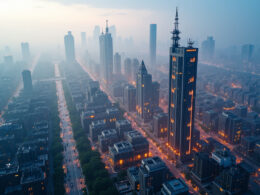On November 22, at 2:53 Eastern Time, a Falcon 9 rocket was launched from Cape Canaveral, Florida, sending 29 Starlink satellites into space. The satellites successfully separated from the rocket’s second stage an hour and five minutes after liftoff. This launch marked the 150th for Falcon 9 in 2025. Previous missions included launches such as O3b mPOWER-E, Crew-10, Bandwagon-3, mPOWER-D, and CRS-33, alongside four separate Starlink missions. The first stage of the Falcon 9 rocket (Booster B1080) successfully returned to Earth for the ninth time, landing on the barge A Shortfall of Gravitas in the Atlantic Ocean.  Source: SpaceX
Source: SpaceX
The launched 29 satellites (group 6-79) boosted the Starlink constellation. According to satellite tracker Jonathan McDowell, the total number of active satellites in the network exceeded 9,000, with more than 10,400 devices launched since 2019. Besides the milestone 150th Falcon 9 launch this year, the mission became the 568th flight of the company’s launch vehicle since 2010.
The continued expansion of the Starlink constellation is set to enhance global internet coverage, aiming to provide connectivity in remote and underserved areas, which aligns with SpaceX’s plan to deploy up to 42,000 satellites in the future. With the introduction of newer satellite variants, improved data transmission rates and reduced latency are expected, potentially revolutionizing internet access worldwide. This year, SpaceX has further accelerated its launch cadence, reflecting significant advancements in reusable rocket technology and impacting the commercial space industry’s competitive landscape.








